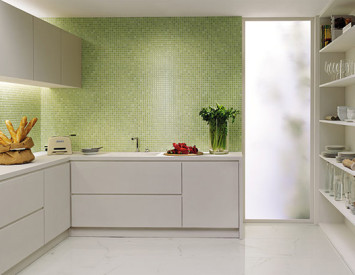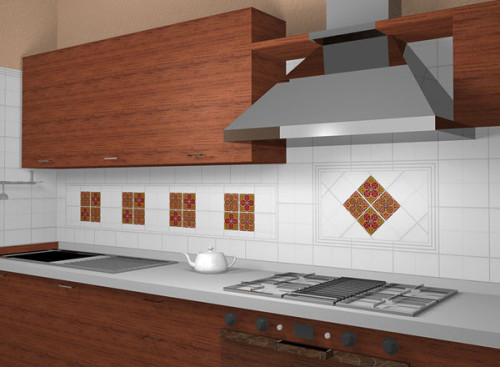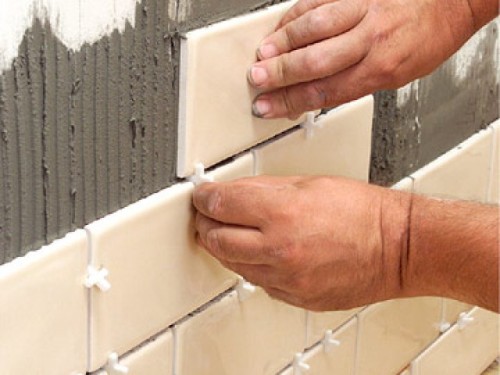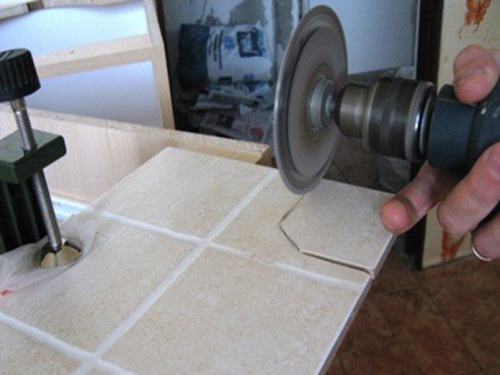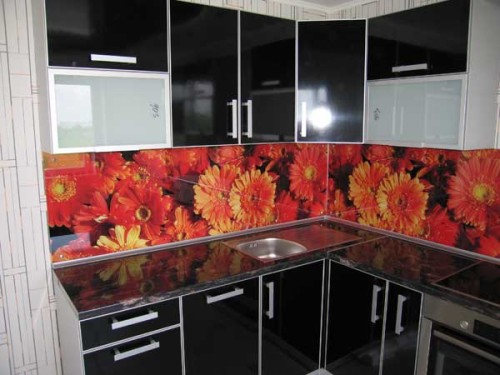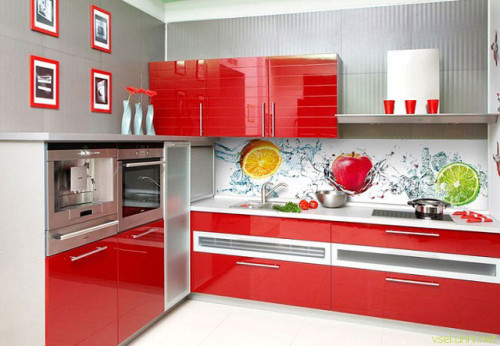The wall area in the working area of \u200b\u200bthe kitchen is most susceptible to pollution. Spray of water from the sink or hot drops of oil from the pan are driven into the walls and are difficult to clean. To facilitate cleaning and for decorative purposes, a kitchen apron is equipped.
Content
An original and practical apron in the working area can be one of the main jewelry of the kitchen. The style and design of the apron for the kitchen is selected taking into account the overall interior. Materials are used by the most diverse. The most common is tile, but protective panels from MDF, plastic, glass and other practical materials are also used. It is not difficult to choose the design of the apron for the kitchen, guided by the photo from the Internet.
Types and materials for kitchen aprons
The apron for a kitchen made of ceramic tiles is traditional. The advantages of such an apron include resistance to water, chemical detergents and temperature differences.
- Ceramic tiles are easily laundered and very durable. You can choose tiles of any color and size. The apron made of tiles, trimmed with contrasting or selected in tone Kant, looks beautiful. Special decorative tiles and panels are often used for inserts.
- Glass protective apron is a fairly new, but promising direction in the field of kitchen design. Beautiful and exquisite paintings are applied with sandblasting machines to the surface of glass panels using laser technologies. Such aprons are performed with a continuous cloth, and there are no joints on the panels. The glass is neutral to any chemical stimuli, and the lack of joints facilitates sanitary treatment. Glass panels are quite expensive, and it is reasonable to attract a specialist to the selection and installation.
- It will be inexpensive to cost the kitchen of plastic. Decorative plastic panels imitate ceramics, wild stone, ceramic tiles, etc. Installation of panels is carried out quickly and is not difficult. Plastic panels have a lot of positive qualities. They weigh little and are easily replaced in case of damage. The only minus of plastic panels is not recommended to use abrasive cleaning substances. Perhaps the occurrence of scratches or scuffs of the facial layer.
You can opt for a kitchen apron from MDF panels, mirror paintings or mosaic smell.
Laying a kitchen apron from ceramic tiles
Equipping an apron for the kitchen, the dimensions are determined based on the expediency. For glass or mirror panels, sizes are set in production.
- Monting the apron independently from ceramic tiles, the length is determined by the location of the sink and the kitchen slab. In a height, the apron is made at the cut of the protective cover of the plate. About 55 cm from the working surface or 1.5 meters and higher from the floor.
- The surface of the wall is prepared for the installation of ceramic tiles. On the marked area of \u200b\u200bthe wall, old wallpaper, paint or other finishing materials and the old plaster are removed to the base. The site is leveled, and in panel houses with concrete walls you can apply a notch with a Christmas tree with an old ax or a chisel.
- The tile is glued from the lower corner. On the back, the glue for tiles on a cement basis is applied with a spatula and is aligned with a spatula. To create even seams, plastic crosses are installed.
- Having set 8 - 10 tiles, check their laying out with a waterpasis, subdue the seams and let the glue grab. You can move and level ceramic tiles for 18 - 20 minutes. Then continue to lay out with small breaks to grasp glue and check the correct laying.
- Remove the crosses as the adhesive solution is set and dried. Clean the tile stained with adhesive during laying. The next day they are engaged in grouting. There is a grout for seams, harmonizing in color, the color of the company or contrasting. Contrast tones of grouts are used in the case of perfectly even seams. The grout color harmonizing with tiles is used to conceal distortions and other flaws during styling.
A steel or rubber spatula is used for grouting joints. For wide seams, an extension is sometimes used.
Installation and installation of panel aprons for the kitchen
- Aprons for the kitchen from plastic panels, MDF, lining or other similar materials are installed according to the same scheme. The height and contour of the apron for the kitchen from the panels are planned taking into account hinged cabinets and kitchen furniture.
- A crate is mounted on the kitchen wall - a frame for fastening panels. The crate is made of wooden beam or profile rail. When selecting the timber, the thickness of the beam and panels itself is taken into account. To save space, the crate is deepened into pre -broken grooves.
- Profile mounting rails are attached to the frame in which the panels are installed. The mount is carried out on mounting screws or special locks.
- The frameless installation of plastic panels is carried out for suitable glue or liquid nails. Having selected materials for the kitchen apron, check the hygienic and high -quality certificate.
Before starting work, you can see the process of installing an apron for the kitchen, the video is at the end of the article. The installation of glass or mirror panels for a kitchen apron is best entrusted to professionals. When installing such panels, it is necessary to take into account many specific nuances and one pair of hands will be few.
